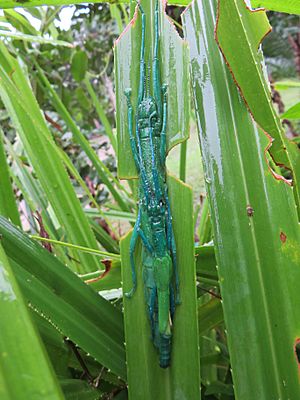Megacrania facts for kids
Quick facts for kids Megacrania |
|
|---|---|
 |
|
| Adult peppermint stick insects mating in Queensland, Australia | |
| Scientific classification |
|
| Kingdom: | Animalia |
| Phylum: | Arthropoda |
| Class: | Insecta |
| Order: | Phasmatodea |
| Family: | Phasmatidae |
| Subfamily: | Megacraniinae |
| Genus: | Megacrania Kaup, 1871 |
Megacrania is a group of amazing stick insects. They belong to a family called Megacraniinae. People often call them "peppermint stick insects." This is because they look like twigs and can spray a special liquid that smells like peppermint!
These unique insects are known for their bright colors, which act as a warning sign to predators. They also have a strong chemical defense system. When they feel threatened, they spray an irritating fluid. This fluid smells like peppermint and comes from special scent glands near their head. It can be painful if inhaled or if it gets on sensitive body parts. This spray is a great way to scare off many predators, like other insects, lizards, and birds.
Contents
What are Peppermint Stick Insects?
Peppermint stick insects are fascinating creatures that blend in perfectly with their surroundings. Their long, thin bodies look just like twigs or branches. This helps them hide from animals that might want to eat them. But if their camouflage doesn't work, they have their secret weapon: the peppermint spray!
These insects are mostly found in places like Australia and parts of Asia. They live in trees and bushes, munching on leaves. They are usually active at night, which is when they feed and move around.
How They Protect Themselves
The peppermint spray is their main way to stay safe. It's a powerful chemical defense. Imagine something spraying a strong, irritating smell at you! That's what these insects do to predators. The spray can make predators feel uncomfortable or even hurt them, teaching them to stay away from peppermint stick insects in the future. This is a clever way for them to survive in the wild.
Discovering Megacrania Species
The Megacrania group of stick insects was first described by a scientist named Johann Jakob Kaup in 1871. Scientists have studied these insects a lot over the years. In 2007, they made some important updates to how the different types of Megacrania were organized. For example, one species, M. batesii, was recognized as its own unique type again.
Today, we know there are 12 different species within the Megacrania group. Each one is a little bit different, but they all share the cool "peppermint" defense.
Known Species of Megacrania
Here are the 12 known species:
- M. alpheus
- M. artus
- M. batesii
- M. brocki
- M. nigrosulfurea
- M. obscurus
- M. phelaus (This is the original type species)
- M. rentzi
- M. spina
- M. tsudai
- M. vickeri
- M. wegneri
In 2020, scientists moved the Megacrania group into a new subfamily called Megacraniinae, also known as palm stick insects. This change happened because new research showed that Megacrania insects are more closely related to each other than to other groups they were previously placed with. This helps us understand the family tree of stick insects better!

